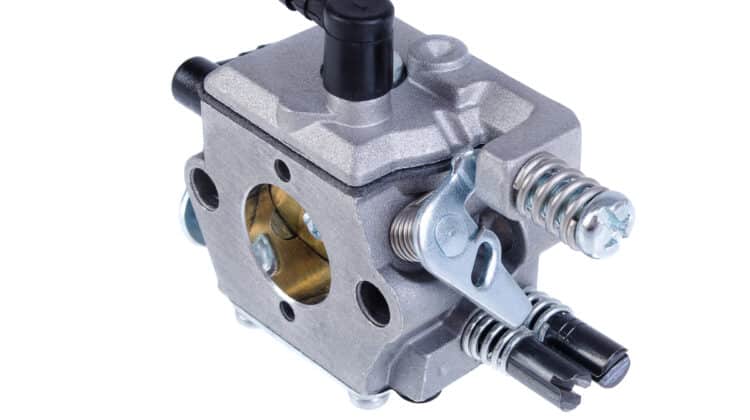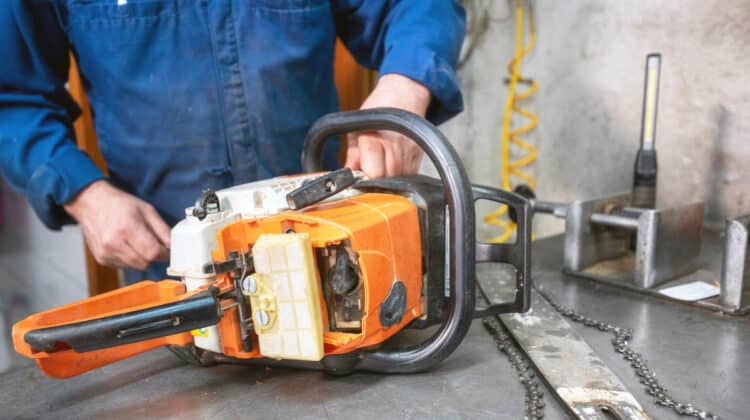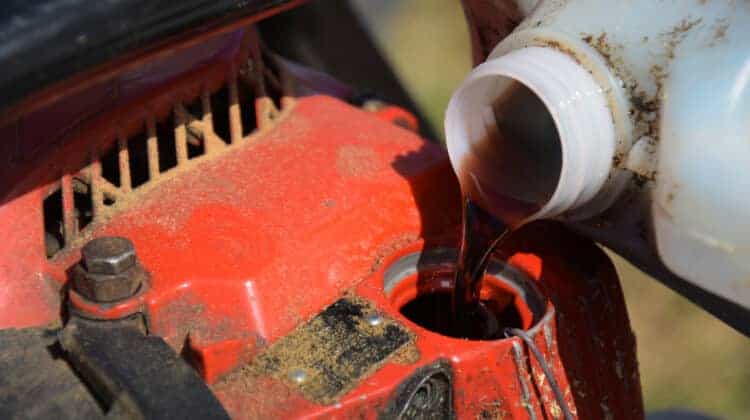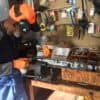
Chains and many two-cycle engines need carburetor adjustments from time to time. One has to ensure that the adjustment is neither too high nor too high. This article is about how to tune a chainsaw carburetor. The good news is that anyone can learn to adjust a chainsaw carburetor so long as they follow the instructions outlined in this article.
Table of Contents
What is a carburetor?
A carburetor is a critical component of a chainsaw. The work of the carburetor is to regulate the amount of fuel used by the chainsaw. So the carburetor must maintain the correct proportion of air/fuel in the chainsaw for best performance. Failure to make the accurate adjustment may cause the machine to malfunction and become hard to use. That is why you should be very careful with the adjustments.
In simple terms, the carburetor takes small quantities of fuel and mixes them with the air entering the engine. It is a critical function of the engine so that the machine can run smoothly. As we have already mentioned, the engine will be lean if there is not enough fuel mixing with the incoming air. On the other hand, the carburetor is running rich if too much fuel is mixing with the air.
Unlike other carburetors in other engines, the carburetor on the chainsaw works only in three situations. They include:
The chainsaw carburetor has to work when:
- starting a cold engine
- the engine is idle
- the engine is open
The main difference between a chainsaw and other carbs is that the chainsaw carburetor doesn’t need incremental performance. For a car carburetor, the gradual increase is critical and that is why the car carburetor is much more complex than the chainsaw carburetor.
The main parts of a carburetor
It is crucial to know the main components/parts of the carburetor if you want to know how to tune a chainsaw carburetor. It is easier to fix something when you understand its parts. Before we look at the main parts of a carburetor, please note that a carburetor is a tube.
The main parts of the carburetor include the following.
Bearing in mind that a carburetor is a tube, it is composed of a brass throttle plate across the chute. The work of the throttle plate is to control the amount of air that flows through the tube. There is also a narrowing inside the duct whose job is to create a vacuum. The narrowing is called a venturi. Within the venturi, there is a hole known as a jet whose work is to allow the vacuum to draw in the fuel.
When the carburetor is operating optimally in a state known as the full throttle, the brass throttle should lie parallel to the length of the tube. It is crucial as it lets the airflow through the carburetor. As the air flows through the carburetor, a vacuum is made in the venturi. This vacuum pulls in a metered amount of fuel. The fuel passes through the jet into the carburetor. When you look at your carburetor, you will see a pair of screws on the top side of the component. The screw labeled ‘Hi’ regulates the amount of fuel that goes into the venturi through the jet when the car is in operation at full throttle.
When the engine is not in operation (idling), the brass throttle plate almost closes. This is to ensure that there is minimal air passing through the venturi. As a result, a vacuum cannot form to allow the fuel to pass through the venturi. Since the brass throttle inhibits the amount of air flowing into the tube, a vacuum is created at the back of the throttle plate. If you happen to drill a hole through the side of the carburetor, you can draw the fuel through the vacuum created by the throttle.
This hole is known as the idle jet. The other crew labeled (LO) regulates the amount of gas that passes through the idle jet. What happens when the engine is cold? Starting a cold engine requires one to pull the cord to start the engine. When the engine starts running, it is said to be running at a very low rpm. To run a cold engine, the carburetor needs to have a rich mixture to start. Get a choke plate at this stage.
The choke plate needs to cover the venturi to achieve that rich mixture. You must leave the throttle plate open and cover the venturi using the choke plate. It allows the vacuum of the engine to let in enough fuel through the two jets (the main jet and the idle jet). This rich mixture will push the engine to fire once or two times. Once you open the choke plates, the engine begins to run normally.
An adjustment that is too strong can cause the chain to emit too much smoke. It can also result in insufficient power and lead to too much buildup of carbon. The engine of the machine can get destroyed as a result.
On the other hand, an adjustment that is too lean can cause a condition known as a lean seizure. Lean adjustment produces insufficient power. This type of adjustment can also destroy the engine. Carburetor adjustment has to be correctly tuned to produce enough power and maintain the engine of the chainsaw. Doing the correct carburetor adjustments also ensures that the chainsaw produces minimal smoke.
A strong carburetor adjustment occurs when the portion of the fuel in the combustible air/fuel mixture is very high and prevents the fuel from burning well. As a result, not enough heat comes out, and this may result in a weak stroke. Since the mixture does not burn well, excess smoke is produced through the muffler. A strong carburetor also causes excess carbon buildup. If you run the engine for a long time, the excess carbon covers the cylinder ports as well as the fire screen. The same effect can also be achieved when one uses old gasoline or when you mix too much oil with the fuel.
A weak/lean carburetor adjustment occurs when the part of fuel in the combustible fuel/air mixture is not sufficient to burn. As a result, there will be weak power stroke and this may be responsible for insufficient power. Apart from low power, there are chances of seizures due to high temperatures in the cylinder. Other factors may contribute to the lean adjustment conditions. An example is an insufficient oil in the gasoline mixture. If you leave the fuel tank to run empty, the carburetor may experience this condition. Check your user manual to learn about the correct oil mixture ratio you should use.
Steps to take to tune a chainsaw carburetor
Now let us look at the steps one needs to take to tune a carburetor. Once you have learned the components of a chainsaw carburetor, it is easy to learn how to tune the carburetor. At some point, you will need to adjust the chainsaw carburetor after using it for some time. When the chainsaw is still new, you don’t have to tune it because it is still at the optimal tunning. However, the chainsaw carburetor cannot stay correctly adjusted on factory settings for long.
Check the chainsaw’s air filter
The first step is to check the air filter. Sometimes the air filter could be dirty and needs to be cleaned up. Failure to clean the filter is not a good idea because you might end up tuning the carburetor with a dirty filter. Makes sure you clean all the dirt clogs before you tune the carburetor.
Open and fill the fuel tank
Once you have cleaned the filter, it is now time to open the fuel tank and check its level. Before you proceed, you have to ensure that the fuel tank is more than 1/2 full. It is critical because you are going to use fuel during the tuning process. Undertaking the adjustment with a low fuel may lead to a carburetor that is too adjusted when you decide to refill the tank. Make sure you run the engine for some time if it is cold to avoid a situation where you are getting a rich adjustment when you start the engine without warming it up.
Measure your chainsaw RPM
Now concentrate on the idle speed which should be around 2700 RPM. You can use a tachometer to measure the starting speed. You can then set the chainsaw to run once the throttle is released. Do not let the chainsaw run idle for long. If you don’t have the tachometer tool, you can try something else. One trick is to set the highest idle speed of the chainsaw without using the clutch. If cannot set the machine to idle, it is time to move to the next step. As a rule of thumb, you should never set the chainsaw to idle and the chain is running while the throttle is released.
Use different screw positions to tune idling speed
If you want to run the chainsaw at low speed, adjust the screws by turning them inwards. It will let the engine starve from fuel. Once that is done, it is time to let the engine run faster by turning the screw outward. You can then start loading it up. The best screw position should be between the second and first positions. It is probably where the machine is idling best.
Finetune using your tachometer readings
If you want the chainsaw to run at high speed, adjust the screw by turning them inwards. It will help you to achieve a lean mixture. Now turn the screw inwards further. You should hear aflutter. Use your tachometer to see whether you have found the correct RPM.
Now the carburetor to your chainsaw is fully tuned and ready to be used.
One question that people ask is: why can’t carburetors be permanently set while they are new?
Well, it is not possible for carburetors to not need any tuning at all. You cannot adjust them when they are new and then forget about tuning the carburetor for the rest of its life for a simple reason. Chainsaws can’t be set at the factor level and stay perfectly tuned thereafter. Because of differences in fuel types, elevation, humidity, fuel age, and general wear and tear of components on the saw, carburetors need frequent tuning and adjustment to continue operating well.
General tips for chainsaw carburetor tuning
When tuning your carburetor, you must ensure that the chainsaw is laying on a flat surface. Slant surfaces can be a problem because they spill the gas from the carburetor or make the machine fall. Ensure to clear any extra items around. Pay particular attention to the chain area. You don’t want accidents or anything to entangle on the chain. This can destroy the item or the chain blade during the adjustment process.
As a precautionary measure, protect your hands with leather gloves and other protective gear. Wearing an overall and a long-sleeved shirt also helps. Chainsaws can cause accidents and one needs to be extremely careful. Make sure there are no children around.
Conclusion
The chainsaw carburetor is a crucial component of the machine. The performance of the chainsaw depends on the condition and efficiency of the carburetor. If you own a chainsaw or you plan to own one, you must learn the components of the chainsaw, especially the carburetor. It is critical that you go further and know the parts of the carburetor and become familiar with how it works. After that, you can then learn how to tune your carburetor.
A carburetor adjustment is necessary and you are going to need one. All chainsaw carburetors need tuning at one point. So you should learn how to adjust the carburetor properly on your own. It is not a complicated thing if you follow the above instructions to the letter. If you need your chainsaw to continue performing at its best, then periodic adjustment of the carburetor is necessary.





